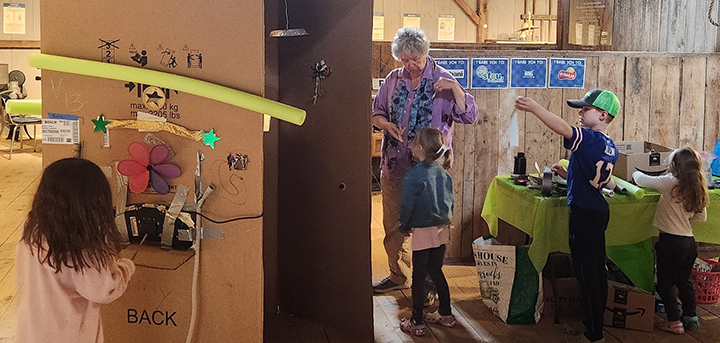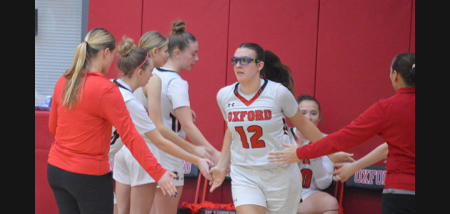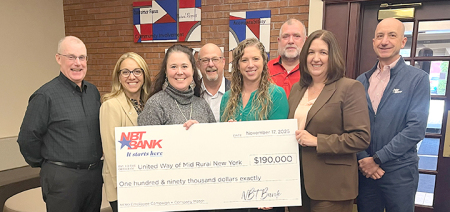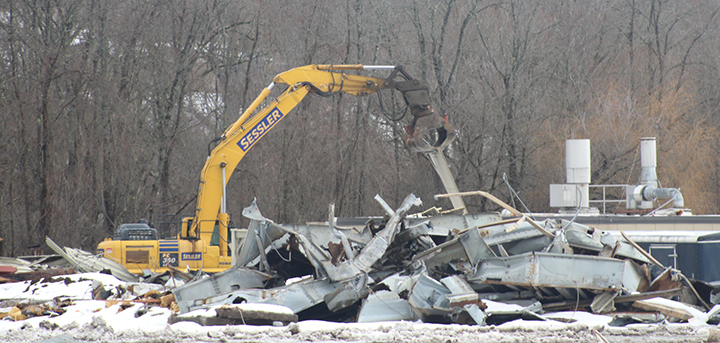Oxford Teachers Awarded 2023 National Excellence In Teaching About Agriculture
Published:
April 12th, 2023
By:
Kelli Miller
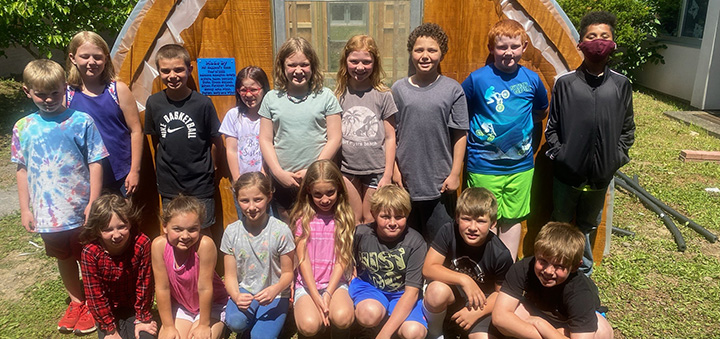 Students at Oxford Elementary School stand in front of the greenhouse they helped fund and build through the STEAM program. A 3D plaque to the side of the door has each students name that helped in the build.(Submitted Photo)
Students at Oxford Elementary School stand in front of the greenhouse they helped fund and build through the STEAM program. A 3D plaque to the side of the door has each students name that helped in the build.(Submitted Photo)
OXFORD — New York Agriculture in the Classroom is proud to announce Megan and Clayton Kappauf as recipients of the 2023 National Excellence in Teaching About Agriculture Award. The Kappaufs’ have created an environment where students are actively engaged in authentic hands-on learning through integrating agriculture and are deserving of this recognition.
The National Agriculture in the Classroom Organization (NAITCO), U.S. Department of Agriculture’s National Institute of Food and Agriculture (USDA-NIFA) and Farm Credit partner each year to honor teachers in pre-kindergarten through 12th grade from around the country for the innovative ways they use agricultural concepts to teach reading, writing, math, science, social studies, STEM, STEAM and more.
New York Agriculture in the Classroom Director Katie Carpenter said, “Megan and Clayton were selected for this award because of their year-round and creative integration of food and agriculture concepts in their classrooms. They use agriculture to illustrate and reinforce core academic concepts and help their students connect what they have to learn with the real world, making their classroom experience come alive.”
“The Kappaufs are also deserving of this honor because of their collaboration across elementary grade levels. Older and younger students are routinely connecting with one another, sharing projects, and engaging in authentic learning experiences alongside each other.
“Each of their classrooms are dynamic environments because of their use of food and agriculture as a lens for learning. Their personal passion for agriculture naturally spills into their classroom, and they are leading the way in creating a generation of agriculturally literate students who understand and can communicate the source and value of agriculture as it impacts their daily lives,” said Carpenter.
Clayton and Megan Kappauf, are a husband-and-wife team who teach at Oxford Academy and Central School District-Primary School and have found creative ways to bring their passion for gardening, food production, and food processing into the classrooms. With the use of equipment such as high tunnels, dehydrators, and aeroponic grow systems, students are exposed to a variety of fresh vegetables, fruits, and herbs.
Megan and Clayton worked together last year but this year are working different positions as she is teaching Universal pre-kindergarten and Clayton teaches third and fourth grades.
“We’re still working collaboratively, we start the plants downstairs in my classroom and grow vegetables such as mescaline mix, onions and cabbages, then we bring them upstairs to the STEAM room where Clayton and his students share in the projects,” Megan said.
Clayton said, “I teach STEAM, thats an acronym for Science, Technology, Engineering, Art, and Math. It’s a big push right now for schools in the area. We just built two areas dedicated to STEAM in the school and have enrolled in a program out of Northwestern University called FUSE, it’s a challenge based approach program. The third and fourth grade students have an option to choose what ever challenge they wish to work on for the day, so kids can be working on five to six different things all in one day.”
According to online source, Resilient Educator, STEAM is the next generation of STEM (Science, Technology, Engineering and Math) and evolved to add an art component. The art is inclusive of the humanities, language arts, and fine arts. STEAM makes education more effective. It takes STEM education and pops it up a few notches by allowing students to apply creative thinking, imagination and design skills.
Upstairs in the STEAM classroom, there are two tall aeroponic towers used for growing different vegetables such many different varieties of lettuce, broccoli and herbs. Clayton said the students eat what they grow and this is the second year of successful growth with the towers.
“Last year, at the National Conference, I presented a 3D aeroponic tower and the blue prints I made to help educate on the components of making an aeroponic tower and how the system works,” Clayton said.
Clayton explained that Aeroponics is the process of growing plants in an air or mist environment rather than soil. The system uses water, liquid nutrients and a soilless growing medium to quickly and efficiently grow tasty, colorful, healthy produce. Utilizing a tower garden for aeroponic plant growth is especially helpful if space is limited.
Also, in the STEAM room there are Three 3D printers, each is used for different jobs and have varying speeds which enable students to create many models. Last year, one student wanted to make a joystick as one of the challenges in the FUSE program was to make a video game. Clayton told the student, if he made the video game, they would also make the joystick to go with it. The third grader made a video game and then they created the 3D joystick along with printed lock and hinges.
“We had NASA here a couple years ago, with one of the robotic programs and they were talking about how they could send a 3D file up to the astronauts who could then print what they needed for a specific tool,” said Clayton.
In the window of the STEAM room, Cabbage sprouts are lined up in individual containers. One sprout per student will be taken home to grow on their own. This is another hands on project for the students to experience growing vegetables and competing for best in New York prize money. Once the cabbage is full grown, each student will take a picture of themselves with their cabbage, weigh it, and if they have the best in New York State, they will win $1,000 from Bonney Plant Third Grade Cabbage Program.
Megan said, “We’ve written a lot of grants and the District has been very supportive allowing us to run with multiple ideas. When you show up and you’re willing to take the time with a new project for the kids, there really isn’t any pushback.”
“Last year the New York State Ag in the Classroom had a program and contest called “School Yard Sugaring”. They sent all of the supplies which included taps, tubing, collection bags and even the hydrometer to test the syrup at the end of processing,” Clayton said.
“Our teachings incorporate a lot of Agriculture into education.We tapped some trees on campus for maple syrup production and are lucky enough to have a great Agriculture program at the high school and an FFA teacher that has an evaporator on campus, so we gathered the sap, took it out back and evaporated it and the kids could see the whole process from start to finish.
“We competed in the contest, “School Yard Sugaring” for the first time last year and the primary school won the competition which awarded a $250 first prize. The students wanted to reinvest the money to buy additional items for the greenhouse we built,” said Clayton.
“Last year, I asked the superintendent if I could use the schools’ empty lawn space to build a greenhouse and he gave his approval. The kids and I began the build and also created a plaque using the 3D printer, which has each students name on it that was involved,” he added.
Clayton explained the Greenhouse is still a work in progress as there isn’t any plumbing yet and they have no heater inside. They’ll need to wait until it warms up a little at night, before actually planting. He said they do have a couple of exhaust fans installed, which will help plants stay cooler in the upcoming warmer temperatures. Old Pre-K napping mats were repurposed to cover and protect the wood stands from future plant waterings and repurposed screen doors were used for both doors, while pulleys help open the doors from the inside.
“Elizabeth Dyck, a local woman that grows grains, came in and did a presentation on how to take wheat germ and process it into flour and then helped the students make the pasta to eat,” Megan said.
“Sort of like the story of the Little Red Hen,” she added. “Something this small, these little granules of grain and grinding can turn into pasta. The take away is that kids learn where food comes from. They can even make it themselves at four years old and everyone is successful.”
Clayton said, “One thing always leads to another as we had so much basil that we decided to make caprese sandwiches that consist of tomato, fresh mozzarella and basil drizzled with balsamic dressing. That led to a lesson on the New York Ag in the classroom metrics of how to make mozzarella cheese and we decided to make that too. We had grown the tomatoes and basil in our tower garden and then we made the cheese, so it was all inclusive.
“The students also learned to market the sandwiches; deciding how much they would sell them for, how they would package them, and what they would use as their sales pitch. They were excited and couldn’t wait to create and come up with new ideas. There was an Ag contest for best macaroni and cheese contest and the kids wanted to add squash flowers grown in the aeroponic towers, so we did. Last years food contest was ‘Top Cut Beef’ and we took third place,” said Clayton.
“The nice thing about doing some of the agriculture activities is that those students struggling in other subjects, have a chance to shine in these projects and feel validated,” Clayton added.
“An outdoor raised garden bed will grow corn, beans, and squash. The garden is named ‘Three Sisters’, as the name comes from the Native American’s Iroquois tribe. They would grow the corn tall and strong for usage while also relying on those stalks to support beans stalks, and plant squash along the base. The leaves on squash plants are prickly and bristly, which helps keep animals away. The three vegetables worked together and flourished, which explains why Native American’s refer to it as ‘The Three Sisters,’” Megan said.
Megan added, “One of the reasons the Three Sisters garden is so important is because we are to teach studies about Native American’s and tying in the social studies curriculum to this garden, allows observation and documentation for the education of the students, plus it’s something that was done so long ago and is still effective today.”
Author: Kelli Miller - More From This Author
Comments

